Flowering plants are a group of plants that bear flowers and fruits at least once in their lifetime. They are also known as the angiosperms. Here we are going to briefly discuss the flowering plant examples.
There are more than 300,000 different species found under angiosperms. Let’s discuss some most common flowering plant examples.
Let’s have a closer look at the flowering plant examples.
Rose
The Rose plant is one of the most common perennial deciduous flowering plant examples, it belongs to the family Rosaceae which is also known as the rose family. There are more than 300 species found under the genus Rosa. Generally, the rose plant is typically a shrub, having alternately pinnate leaves and basal stipules. The plant produces colourful flowers having five petals and five petals each. The flower produces berry-like fruit called rosehip.
Adenium
Adenium, also commonly known as the Desert Rose, is one of the most common flowering plant examples. It belongs to the family Apocynaceae, native to Africa and Arabian Peninsula. The plant is a deciduous succulent shrub. The flower of adenium is multi-coloured and has five petals each, long and tubular in shape. It is mostly used as an ornamental plant.
China rose
China rose or Hibiscus is an annual, perennial, herbaceous plant or small woody shrub, one of the most common flowering plant examples. It belongs to the family Malvaceae typically known as the mallow family. There are more than 679 different species found under the genus Hibiscus, among them Hibiscus rosa Sinensis is one of the most common species. Hibiscus syriacus is mostly popular as an ornamental plant. The plant produces dry five-lobed capsules like fruits, containing multiple seeds.
Bougainvillea
Bougainvillea plant is an ornamental plant group, belonging to the family Nyctaginaceae, also known as the four O’clock family. It is also one of the most common flowering plant examples. The plants are mostly bushes or vines, which live by scrambling over other plants with their spiky thrones. The plant produces white, pink, magenta, purple, red and orange coloured flowers. Because of the thin and papery bract, the Bougainvillea glabra is also called a paper flower.
Jasmine
Jasmine or Jasminum is a tropical plant typically belonging to the family Oleaceae, which is known as the olive family. These are shrubs or vines that produce white coloured flowers at the time of autumn. It is one of the most common flowering plant examples, mostly found in the Eurasian and African regions.
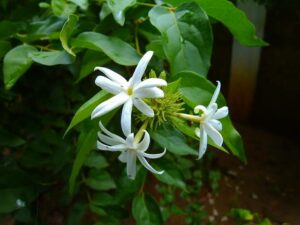
Jasmine plant from Pixabay.com
Daisy
Daisy or Bellis perennis is a perennial herbaceous plant, belonging to the sunflower family Asteraceae. The pseudanthium flowers consist of many white ray florets and one orange disc floret, which is surrounded by green bracts. The Daisy is also called the eye of the day because at night time the whole head of the flower closes and opens the next morning.
Marigold
Marigold or Tegetes is a herbaceous annual plant, one of the most common flowering plant examples. It belongs to the sunflower family Asteraceae. The plant bears golden, orange, and yellow coloured flowers with maroon highlights sometimes. The plant consists of a fibrous root system.
Dandelion
Taraxacum or dandelion is a perennial herbaceous plant, native to the Eurasian region. It belongs to the sunflower family Asteraceae and is one of the most common flowering plant examples. The flowers of dandelion are composite into a flower head where each of the single flower heads is a floret. The yellow or white coloured flowers remain open in the daytime and at night closes.
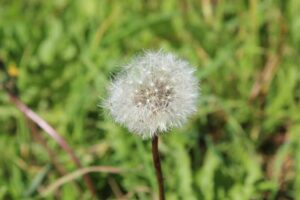
Dandelion from Pixabay.com
Tulip
Tulip or Tulipa is one of the most common flowering plant examples belonging to the family Liliaceae, the Lily family. It is a perennial herbaceous bulbiferous plant native to the Eurasian region. The plant bears colourful flowers at the time of spring. The cup or star-shaped flowers are usually radially symmetrical, surrounded by two whorls of tepals. Both androecium and gynoecium are present in the same flower, producing capsule-like fruits.
Orchid
Orchids are perennial herbaceous plants, one of the most common flowering plant examples. It belongs to the family Orchidaceae, under which more than 28,000 different species are found. It is a monocot plant having a simple leaf structure with parallel veins. The orchid plant produces colourful flowers with an outer whorl made of sepals and inner whorl made consisting of petals.
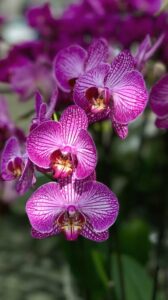
Orchid from Pixabay.com
Aloe Vera
Aloe vera is a perennial monocot plant species, one of the most common flowering plant examples. There are more than 500 species found under the genus Aloe. It is an evergreen plant that grows mostly in tropical and subtropical regions. The aloe vera makes arbuscular mycorrhiza. It is a flowering plant that produces yellow coloured small flowers at the time of summer.
Lavender
Lavender or Lavandula is a perennial herbaceous dicot plant species, one of the most common flowering plant examples. The plant belongs to the mint family Lamiaceae, having about 50 different species under the genus. Lavandula angustifolia is the most cultivated species among all. The plant produces blue, violet or blackish purple coloured flowers. It is mostly cultivated for its essential oil. It is also used in making medicine and cosmetics.
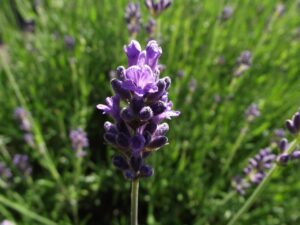
Lavender plant from Pixabay.com
Lily
Lilium or lily is a perennial deciduous herbaceous plant belonging to the family Liliaceae. It is a monocot plant species, one of the most common flowering plant examples. The plant produces yellow, white, red, orange, and purple coloured flowers in the season of spring or summer. The plant bears capsule-like fruits, ripe in late summer. It is widely cultivated in tropical and sub-tropical regions.
Sunflower
Sunflower or Helianthus is a dicot plant species, one of the most common flowering plant examples. It belongs to the family Asteraceae, more than 70 species found under the genus Helianthus. Sunflower is native to the north and Central American regions. The plant shows heliotropism when it starts blooming the flowers’ heads tracking the sun. The flowers consist of terminal capitula with several yellow coloured rag florets and a maroon coloured disc floret.
Angelonia
Angelonia is a herbaceous dicot plant, one of the most common flowering plant examples. It belongs to the family Plantaginaceae. There are more than 30 plant species found under the genus Angelonia. Angelonia grandiflora is a species mainly used as an ornamental plant. It is native to the tropical regions, mostly found in northeastern Brazil. The plant produces colourful pink shaded flowers. It is a specialized pollination, producing special oil from the inner corolla to attract pollinators.
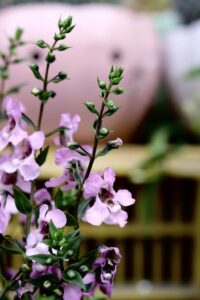
Angelonia plant from Pixabay.com
Daffodils
Daffodil or Narcissus is a perennial herbaceous monocot plant belonging to the family Amaryllidaceae. The plant bears solitary white or yellow coloured flowers. The flowers are mostly hung down and hermaphrodite means have both the male and female reproductive structures in it. There are six pollen-bearing stamens. The flowers produce capsule-like fruits which split to release seeds.
Veronica
Veronica is a herbaceous annual plant species belonging to the family Plantaginaceae. It is one of the most common flowering plant examples. There are more than 500 species found under the genus Veronica. It produces small colourful mostly violet, purple or Lavender coloured flowers. For nutritional value, the plant is also used in medicines. The plant is also known as speedwell, bird’s eye, etc.
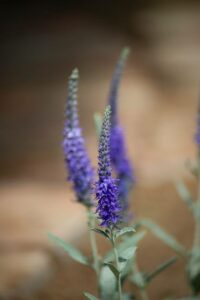
Veronica from Pixabay.com
Musk rose
Musk rose or Rosa moschata is a dicot plant species, one of the most common flowering plant examples. It belongs to the rose family Rosaceae. It is mostly found in the western Himalayan regions. The plant is a shrub that produces white coloured flowers at the time of summer or autumn. It releases a musky scent that is why it is called Musk rose.
Dahlia
Dahlia is a tuberous, perennial herbaceous plant species, one of the most common flowering plant examples. It belongs to the sunflower family Asteraceae. There are more than 40 species found under the genus Dahlia. The flower consists of several colourful ray florets outside and a disc floret inside. It is native to the American and Mexican regions. It is also declared the national flower of Mexico.
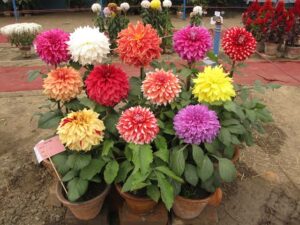
Dahlia from Wikimedia Commons
Lotus
Lotus or Nelumbo nucifera is an aquatic dicot plant species, one of the most common flowering plant examples. It belongs to the family Nelumbonaceae. It is native to the Asian regions mostly found in central and northern India. It is the national flower of India. As it is an aquatic plant the leaves float on the water surface and the roots are planted under the soil of the pond. The plant produces whitish-pink coloured flowers.
Gulmohar
Gulmohar or Delonix regia is a large deciduous dicot tree, one of the most common flowering plant examples. It belongs to the grass family Fabaceae. It is native to the tropical and subtropical regions. The plant species is also known as flame of forest, forestflame or royal poinciana. In the spring season red, orange, and yellow coloured flowers are produced. In the Indian subcontinent, the plant is called the Krishna Chura tree.
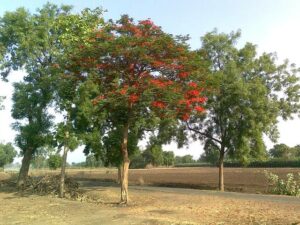
Gulmohar tree from Wikimedia Commons
Zinnia
Zinnia is an annual shrub species, belonging to the sunflower family Asteraceae. The zinnia plant is also one of the most common flowering plant examples. There are several different species found under the genus. It is native to the American regions. The plant produces white, yellow, red, and purple coloured flowers.
Hydrangea
Hydrangea is a flowering plant species, belonging to the family Hydrangeaceae. It is a native plant to the Asian and American regions. At the time of spring and autumn, the plant produces colourful flowers. It is a popular ornamental plant.
Kalanchoe
Kalanchoe is a perennial herbaceous plant species, one of the most common flowering plant examples. It belongs to the family Crassulaceae. There are more than 125 species found under the genus. It is native to the Madagascar region. The plant produces colourful small flowers.
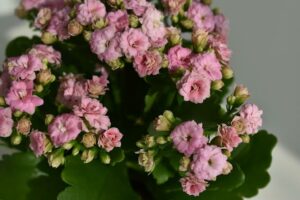
Kalanchoe plant from Pixabay.com
Ixora
Ixora is also one of the most common flowering plant examples, belonging to the family Rubiaceae. The genus consists of more than 500 different plant species. It is native to the tropical and subtropical regions. The plant bears colourful mostly red, pink coloured flowers in the summer season.
As a whole, we can say that angiosperm plant species play a significant role in maintaining biodiversity. Here we mention some most common flowering plant examples. We also see both monocot and dicot plants produce flowers and fruits. Hope this article on flowering plant examples will be helpful to you.
Please click here to learn more about Non Flowering Plant Example.
Also Read:
- Centipede characteristics
- Channel protein function
- Cofactor examples
- Fibrous protein function
- Lysosomes and golgi apparatus
- Is secondary transport active
- Is chromosome a chromatid
- Do bacteria have lysosomes
- Exotic species examples
- Silverfish types

Hello, I am Piyali Das, pursuing my Post Graduation in Zoology from Calcutta University. I am very passionate on Academic Article writing. My aim is to explain complex things in simple way through my writings for the readers.